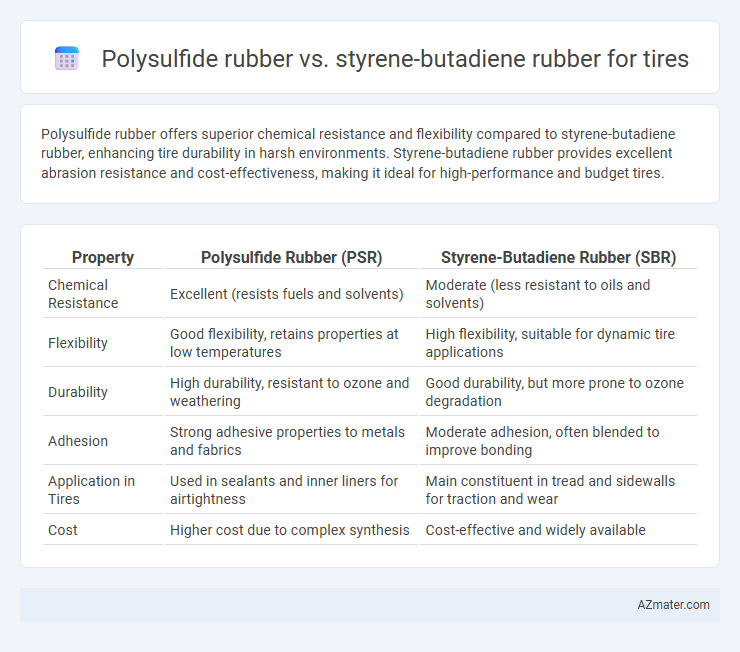Polysulfide rubber offers superior chemical resistance and flexibility compared to styrene-butadiene rubber, enhancing tire durability in harsh environments. Styrene-butadiene rubber provides excellent abrasion resistance and cost-effectiveness, making it ideal for high-performance and budget tires.
Table of Comparison
| Property | Polysulfide Rubber (PSR) | Styrene-Butadiene Rubber (SBR) |
|---|---|---|
| Chemical Resistance | Excellent (resists fuels and solvents) | Moderate (less resistant to oils and solvents) |
| Flexibility | Good flexibility, retains properties at low temperatures | High flexibility, suitable for dynamic tire applications |
| Durability | High durability, resistant to ozone and weathering | Good durability, but more prone to ozone degradation |
| Adhesion | Strong adhesive properties to metals and fabrics | Moderate adhesion, often blended to improve bonding |
| Application in Tires | Used in sealants and inner liners for airtightness | Main constituent in tread and sidewalls for traction and wear |
| Cost | Higher cost due to complex synthesis | Cost-effective and widely available |
Introduction to Polysulfide Rubber and Styrene-Butadiene Rubber
Polysulfide rubber (PSR) is a high-performance elastomer known for its excellent chemical resistance, low permeability to gases, and superior flexibility, making it suitable for specialized tire applications requiring enhanced durability. Styrene-butadiene rubber (SBR), a synthetic copolymer widely used in tire manufacturing, offers a balanced combination of abrasion resistance, aging stability, and cost-effectiveness, making it the most common choice for passenger car and truck tires. Both polymers serve distinct purposes in tire technology, with PSR favored for niche applications demanding superior chemical and environmental resistance and SBR dominating bulk tire production due to its versatile performance characteristics.
Chemical Structure and Composition Comparison
Polysulfide rubber features a backbone of repeating sulfide (-S-) linkages providing high resistance to chemicals and heat, whereas styrene-butadiene rubber (SBR) consists of styrene and butadiene monomers arranged in a random copolymer structure offering excellent abrasion resistance and aging stability. The sulfur bridges in polysulfide rubber enhance crosslink density, improving elasticity and impermeability, while SBR's hydrocarbon chains result in versatile mechanical properties suited for tire tread compounds. Chemical composition differences dictate polysulfide's superior chemical resistance and SBR's balanced performance in wear and weathering for tire applications.
Manufacturing Processes of Both Rubbers
Polysulfide rubber manufacturing involves the condensation polymerization of organic polysulfide monomers, creating a dense, cross-linked polymer network with excellent chemical resistance. Styrene-butadiene rubber (SBR) is produced through copolymerization of styrene and butadiene via emulsion or solution polymerization, allowing control over polymer microstructure for enhanced abrasion resistance and durability. The distinct polymerization techniques impact tire performance by influencing rubber elasticity, aging resistance, and processability during tire assembly.
Mechanical Properties: Strength and Flexibility
Polysulfide rubber exhibits superior tensile strength and excellent oil resistance, making it highly durable for tire applications requiring chemical stability. Styrene-butadiene rubber offers balanced mechanical properties with high abrasion resistance and enhanced flexibility, improving tire performance in varying temperature conditions. The elasticity of styrene-butadiene rubber allows better impact absorption, while polysulfide rubber excels in maintaining structural integrity under mechanical stress.
Durability and Wear Resistance
Polysulfide rubber demonstrates superior chemical resistance and durability in harsh environments, making it highly effective for tire applications requiring extended service life. Styrene-butadiene rubber (SBR) offers excellent abrasion resistance and strong wear properties, commonly enhancing tread life and traction in standard tire usage. The blend of polysulfide rubber's chemical stability and SBR's wear resistance often results in a balanced tire compound optimized for longevity and performance.
Traction and Performance in Tires
Polysulfide rubber offers superior chemical resistance and improved traction on wet surfaces due to its unique sulfur cross-linking, enhancing tire grip in adverse weather conditions. Styrene-butadiene rubber (SBR) provides excellent abrasion resistance and balanced wear performance, contributing to longer tire life and consistent traction on dry roads. In tire applications, polysulfide rubber is preferred for enhanced wet traction, while SBR excels in overall durability and performance across various driving conditions.
Environmental Impact and Sustainability
Polysulfide rubber exhibits superior chemical resistance and durability, reducing tire degradation and extending tire life, which contributes to lower environmental waste compared to styrene-butadiene rubber (SBR). SBR is more commonly used due to cost-effectiveness but generates higher microplastic pollution and requires more frequent replacement, increasing overall environmental impact. Advancements in polysulfide rubber recycling processes enhance sustainability by enabling more efficient rubber recovery and reuse in tire manufacturing.
Cost Analysis and Economic Considerations
Polysulfide rubber typically incurs higher material and processing costs compared to styrene-butadiene rubber (SBR) due to its complex synthesis and sulfur crosslinking requirements. SBR remains the cost-effective choice for tire manufacturing, offering a balance of performance and affordability with widespread availability and established production methods. Economic considerations favor SBR for large-scale tire production, while polysulfide rubber is reserved for specialized applications where superior chemical resistance justifies the added expense.
Common Applications in the Tire Industry
Polysulfide rubber is primarily used in tire inner liners and sealants due to its excellent gas barrier properties and resistance to oils, enhancing tire durability and air retention. Styrene-butadiene rubber (SBR) is widely employed in tire treads and sidewalls for its superior abrasion resistance, aging stability, and cost-effectiveness, making it a popular choice for passenger car and truck tires. Both rubbers contribute to tire performance, with polysulfide enhancing inner tire integrity and SBR providing wear resistance and flexibility in the outer components.
Summary: Choosing the Right Rubber for Tire Production
Polysulfide rubber offers excellent chemical resistance and flexibility, making it suitable for tire applications requiring enhanced durability against oils and solvents. Styrene-butadiene rubber (SBR) provides superior abrasion resistance and cost-effectiveness, widely used for standard tire treads due to its balance between performance and affordability. Selecting the right rubber depends on specific tire performance requirements, with polysulfide rubber favored in specialized environments and SBR dominating general-purpose tire manufacturing.

Infographic: Polysulfide rubber vs Styrene-butadiene rubber for Tire
 azmater.com
azmater.com